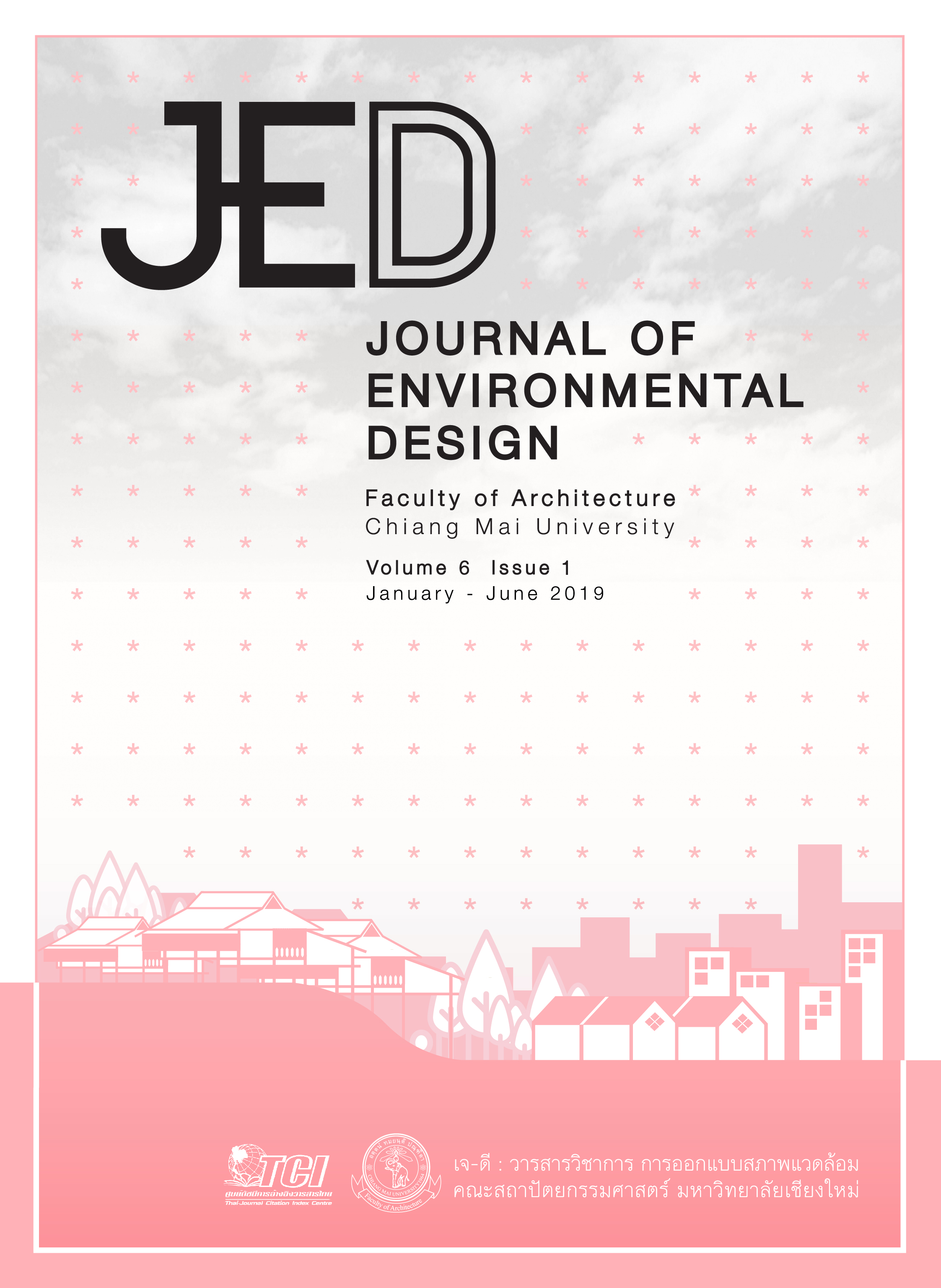เรือนละเวือะแบบจารีต อำเภอแม่แจ่ม จังหวัดเชียงใหม่ เรือนละเวือะแบบจารีต อำเภอแม่แจ่ม จังหวัดเชียงใหม่
Main Article Content
บทคัดย่อ
กลุ่มชาติพันธุ์ละเวือะ พูดภาษาตระกูลออสโตรเอเชียติก เป็นกลุ่มชาติพันธุ์ที่ตั้งถิ่นฐานดั้งเดิม
ในเอเชียตะวันออกเฉียงใต้ภาคพื้นทวีป ก่อนที่กลุ่มชนชาติพันธุ์ผู้พูดภาษาตระกูลไทจะเคลื่อนย้ายเข้ามา เนื่องจากต้องการศึกษาเรือนแบบจารีต ผู้วิจัยใช้หมู่บ้านชาติพันธุ์ละเวือะ อำเภอแม่แจ่ม จังหวัดเชียงใหม่
เป็นพื้นที่กรณีศึกษาที่ยังรักษาขนบธรรมเนียมประเพณี และจารีตต่างๆ ที่เกี่ยวเนื่องกับสิ่งแวดล้อมสร้างสรรค์ และสถาปัตยกรรมพื้นถิ่นได้มากกว่าชุมชนอื่นๆ ที่ตั้งอยู่ใกล้กับชุมชนเมือง จากการเก็บข้อมูลภาคสนาม
พบว่า พัฒนาการของเรือนพื้นถิ่นในชุมชนกรณีศึกษา สามารถแบ่งเป็น 3 กลุ่ม คือ 1) เรือนแบบจารีต
2) เรือนที่มีพัฒนาการจากการต่อเติม ทว่ายังคงแสดงลักษณะของเรือนดั้งเดิม และ 3) เรือนแบบแผนใหม่ อย่างไรก็ตาม สำหรับบทความนี้ ผู้วิจัยมุ่งอธิบายเฉพาะเรือนแบบจารีต ซึ่งมีความเสี่ยงต่อการสิ้นสูญไปในอนาคต เพราะปัจจุบันเหลือเรือนรูปแบบดังกล่าวเพียงหลังเดียวในหมู่บ้าน โดยใช้ระเบียบวิธีวิจัยเชิงคุณภาพที่เน้นกระบวนการบันทึกข้อมูลภาคสนามด้วยวิธีการสังเกต การสำรวจรังวัดอาคาร การสัมภาษณ์เจ้าของเรือนและผู้ทรงคุณวุฒิ การศึกษาพบว่าเรือนแบบจารีตมีรูปทรงทางสถาปัตยกรรมและลักษณะการใช้สอยพื้นที่ภายในเรือนที่สัมพันธ์กับวิถีชีวิตขนบธรรมเนียมประเพณี รวมไปถึงความเชื่อที่สัมพันธ์กับผังพื้นของเรือนในระดับต่างๆ อย่างเป็นระบบ อีกทั้งยังสามารถอธิบายสภาพแวดล้อมสรรสร้างในการกำหนดให้เห็น
การวางตัวขององค์ประกอบด้านพื้นที่ภายในเรือนอย่างเด่นชัดขึ้น นำไปสู่การตั้งข้อสังเกตของที่ตั้งเรือน ทิศทางของเรือน รูปทรงของเรือนและทิศทางของพื้นที่ใช้สอยภายใน สอดประสานให้เห็นถึงปัจจัยในการก่อรูปเรือนแบบจารีต ซึ่งอธิบายผ่านข้อมูลและข้อจำกัดของพื้นที่วิจัยเพื่อให้สามารถอภิปรายและสะท้อนให้เห็นถึงรูปแบบอันเก่าก่อนของเรือนในชุมชนกรณีศึกษานี้ได้ ทั้งนี้เพื่ออภิปรายผลในประเด็นเรื่องรูปทรงทางสถาปัตยกรรม โครงสร้าง การจัดวางพื้นที่ใช้สอยภายในเรือน พื้นที่ศักดิ์สิทธิ์และพื้นที่ทางความเชื่อภายในเรือน ซึ่งจะเป็นคุณูปการในการสร้างสถานะภาพความรู้เกี่ยวกับสถาปัตยกรรมเรือนที่อยู่อาศัยของกลุ่มชนชาติพันธุ์ที่มีการตั้งถิ่นฐานเก่าแก่ที่สุดกลุ่มหนึ่งในภูมิภาคเอเชียตะวันออกเฉียงใต้ภาคพื้นทวีปให้สมบูรณ์ยิ่งขึ้น
Article Details
เอกสารอ้างอิง
Meteorological Department. (2016). Climatological data “Annual weather report” Meteorological Station of Chiang Mai. Bangkok: Meteorological Department.
Panin, O. (1997). Sathapattayakam puentin pak nue prophet ruean teeyu asai. (In Thai) [Vernacular architecture in the north of Thailand]. Bangkok: Siambooks and publications.
Pawarachan, S. (1994). Ruean chonnabot. (In Thai) [Rural house in Thailand]. Chiang Mai: The Office of Arts and Culture, Chiang Mai Rajabhat University.
Prachameeboon, B & Prachameeboon, S. (2016, June 4). Interview. Coordinator of village community, Meachaem, Chiang Mai.
Prachameeboon, T. (2016, June 5). Interview. House’s owner, Mea Chaem, Chiang Mai.
Prachoubmoa, C., et al. (2012). Pritsana wongsakhanayat “Lua”. (In Thai) [Question of lue ethnic group]. Bangkok: Princess Maha Chakri Sirindhorn Anthropology Centre.
Rapoport, A. (1969). House form and culture. Englewood Cliffs: Prentice–Hall.
Ratthikanok, T. (1969). Ngan wijai prawattisat lae manutsayawitthaya rueng Lawa Bo Luang. (In Thai) [History and anthropology of Lawa at Baan Bo Laung]. Chiang Mai: Faculty of Humanities, Chiang Mai University.
Thosaroth, N. & Rathnakul, S. (1996). Saranukrom chatiphan Lawa. (In Thai) [Encyclopedia of Lawa]. Nakhon Pathom: Research Institute for Languages and Cultures of Asia, Mahidol University.
Village Headman. (2016, December 5). Interview. Community leader & village headman, Meachaem, Chiang Mai.


